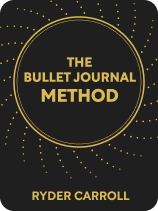

This article is an excerpt from the Shortform book guide to "The Bullet Journal Method" by Ryder Carroll. Shortform has the world's best summaries and analyses of books you should be reading.
Like this article? Sign up for a free trial here .
Do you have a bullet journal? Do you take the time to reflect back on previous days, months, or years?
According to Ryder Carroll, the author of The Bullet Journal Method, bullet journal reflection is an integral part of the bullet journaling method. Carroll suggests reviewing your entries every morning and night, every time you start a new month, and every new year.
Here’s how and why you should review and reflect on your bullet journal.
Daily Review
Carroll explains that because you start each day with a fresh daily record, you have the opportunity for daily bullet journal reflection as you assess what you’ve written and transfer information to other parts of your journal. He recommends that you practice reflection twice every day—in the morning and at night—and spend as much time on this as you need, as long as the time spent is manageable enough to maintain a consistent habit.
Morning Review
Carroll suggests that you take a few moments at the start of your day to unload your mind and review the previous entries in your journal. If any thoughts came up overnight, add them to the current day’s daily record. For example, maybe you remembered upon waking that you have to buy milk at the grocery store.
(Shortform note: Taking part in morning reflection as Carroll suggests could be difficult for those who struggle to feel alert after waking. If this is true for you, try folding your morning review into a wake-up ritual to get you energized—like taking a walk in the sunlight, having a cup of coffee or tea, or taking a cold shower.)
Next, he says to scan recent pages for open tasks (•) or scheduled events (◦) that you haven’t yet transferred to another part of your journal. Where you’ll transfer the task or event depends on its status. For instance, if a task needs your immediate attention, transfer it to your next daily record. If it’s less urgent, transfer it to your monthly log (changing the (•) to (>)) or future log (changing the (•) to (<)). As for events, either copy them to the calendar of your monthly log or to your future log.
(Shortform note: Carroll suggests that you transfer tasks based on urgency, but he doesn’t acknowledge how difficult it can be to determine whether a task truly requires your immediate attention. It’s easy to feel as if every task needs to be addressed right away, and that can influence you to transfer more tasks to your next daily record than you can reasonably accomplish in a day. Unfortunately, the more entries you add to your to-do list, the more likely you are to have multiple unrelated goals competing for your attention—the perfect storm for stress and decreased motivation. Therefore, be cautious as you transfer tasks across your journal, and make sure not to move too many to tomorrow’s to-do list.)
Nightly Review
Similarly, Carroll suggests that you take time to review your journal before going to bed each night. Doing so will allow you to reflect on your progress and experiences. To complete your nightly review, he advises that you briefly scan your daily record and add anything that’s missing—tasks, experiences, or notes you don’t want to forget. As you review, reflect on the importance of each item, what you can learn from it, and why it’s on your list.
(Shortform note: Although Carroll doesn’t address any specific benefits of reviewing your journal at night, research suggests that writing down your to-dos before bedtime could positively impact your sleep. In particular, one study found that people who wrote down their to-do lists before bed fell asleep nine minutes faster than those who wrote about what they had already done that day. The researchers hypothesized this was because writing down the next day’s tasks acted as a way to unload burdensome thoughts that would have kept participants awake. While nine more minutes of sleep per night may not seem like a lot, that little bit of extra time totals to more than 2,737 hours over 50 years.)
Monthly Review
Carroll explains that just as the creation of a new daily record provides chances for reflection, the creation of a new monthly log offers a similar opportunity as you review and transfer the previous month’s entries.
Like the morning review process, Carroll advises that you scan the pages of the last month and look for any open tasks (•) that got left behind in your daily records or last monthly log. For any tasks that fall outside of the new month, transfer them to your future log. Otherwise, transfer uncompleted tasks to the task list of the new monthly log or a separate customized section of your journal. Additionally, Carroll recommends you check your future log for any scheduled tasks or events for this month and transfer them to the task list and calendar of your new monthly log.
Carroll adds that once again, as you review each of these entries, take time to reflect on the value each of them adds to your life. If a task isn’t worth your time or is no longer relevant, don’t waste your time transferring it—simply cross it out.
| Expanding on the Monthly Review Carroll recommends that you reflect on the value of each entry that you transfer, but he doesn’t give any practical tips for how to do this. How can you determine whether the way you’re spending your time is worthwhile? One strategy you can use is making a list of everything significant that happened over the last month. Include not only achievements but also impactful events or changes. By thinking about the most important moments of your month, you’re indirectly deciding what your priorities are—they wouldn’t make the list if they weren’t valuable to you in some way. Another approach to reflecting on what’s valuable to you is to conduct a time audit, which involves comparing how you wanted to spend your time at the start of the month to how you actually spent it. There will no doubt be differences, and getting a clear picture of how you’re really allocating your energy can help you see whether your priorities have changed and whether your actions truly align with your values. |
Yearly Review
Like the tradition of making new year resolutions, Carroll encourages you to reflect on the past year by reviewing your journal and migrating content to a new notebook. Regardless of whether you filled your previous notebook, he recommends that you begin a new one at the start of the year. Starting with a blank slate not only encourages reflection but also increases your motivation.
(Shortform note: Research supports Carroll’s claim that starting fresh increases motivation. For example, a series of studies found that behaviors such as Google searches for “diet” and the number of gym visits increased after salient temporal landmarks like new months, new semesters, and holidays. The researchers concluded that these apparent increases in motivation occurred because participants viewed their past imperfections as belonging to a previous time period once they reached a new temporal landmark—essentially providing a fresh start.)
As you review your journal, Carroll says you should only transfer what’s valuable to you. For example, if your previous year’s future log is full of untouched tasks, it’s likely they’re not important enough to deserve your attention in the new year—if they were, you would have already done them. If you feel uncertain about what to transfer, Carroll recommends asking yourself meaning-focused questions like those used during your daily and monthly reviews.
| Practical Exercises for Letting Go of What’s No Longer Valuable While asking questions as Carroll recommends can be a good starting point in your yearly reflection, there are more practical exercises you can learn to let go of what’s no longer valuable to you. One strategy is to reflect on the role of desire versus duty in your priorities: Generally, unless it’s an absolute necessity, a task done out of obligation doesn’t add the same value to your life as one that you choose to do. Therefore, if a task feels like a duty rather than a desire, you can likely leave it behind. Another strategy is to pause to write out your internal monologue when your mind feels cluttered. Once you’ve done this exercise several times in a week, read through your monologues and look for patterns of thoughts and feelings that can help you identify your values. For instance, if a certain topic comes up again and again accompanied by negative feelings, that may be a sign to let it go. Finally, one last strategy is to make a list of your obligations, habits, hobbies, goals, commitments, and relationships. Once you have a complete inventory, try to reduce your list by 30% based on instinct. Whatever makes the cut is likely something you value; whatever doesn’t is probably something you no longer need. |

———End of Preview———
Like what you just read? Read the rest of the world's best book summary and analysis of Ryder Carroll's "The Bullet Journal Method" at Shortform .
Here's what you'll find in our full The Bullet Journal Method summary :
- A comprehensive guide to using the Bullet Journal Method
- How to maintain a journaling practice that can improve your overall quality of life
- How to extend the method beyond productivity to a practice in mindfulness






